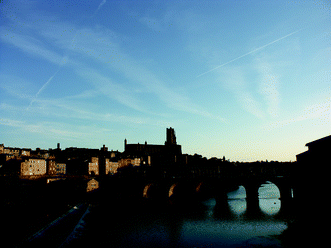International glow discharge spectroscopy symposium, Albi, France, August 22–25, 2010
Philippe
Guillot
,
Cornel
Venzago
and
Gerardo
Gamez
Organizing committee of the International Glow Discharge Spectroscopy Symposium,
The IGDSS took place at the Centre Universitaire Jean-Francois Champollion in the fair city of Albi, on the banks of the Tarn River in south-west France. The layout of Albi is dominated by Sainte-Cecile cathedral, a formidable fortress and vigilant guardian of the city. Albi has just been recognized by the UNESCO World Heritage Centre and served as the perfect venue for the IGDSS.
The city of Albi, France, was the ideal setting for IGDSS.
A kind welcome reception preceded a program with invited lectures from top scientists scheduled throughout three days. Gary Hieftje from Indiana University-Bloomington, USA, gave the opening lecture where he showed how atmospheric pressure glow discharges can be used in analytical spectroscopy. Annemie Bogaerts from the University of Antwerp, Belgium, reviewed her modelling results on atmospheric pressure discharges, as well as the effect of molecular gases on argon glow discharges. Kim Marshall from LECO Corporation, USA, illustrated how the fundamentals of GD spectroscopy mold instrument design. Jean-Pierre Boeuf from the University of Toulouse, France, gave an overview of glow discharge physics in different applications and how it can be better understood through modelling. Zdenek Weiss from LECO Instrumente, Czech Republic, shared insights into the requirements for a glow discharge emission spectra catalog and how far it is towards completion. Arne Bengston from Swerea KIMAB, Sweden, talked about the challenges of depth profiling corrosion products by GDOES. Patrick Chapon from Horiba Jovin Yvon, France, gave an overview of how an industrial company can participate in European projects for developing new products such as the GD ToF-MS. Finally, Volker Hoffmann from IFW Dresden, Germany, provided several examples of new instrumentation developments in rf GDOES. These invited lectures where intercalated with talks from up and coming scientists as well as other experts in the field. Also, a poster session served as the meeting point for discussion on the first day of the symposium.
It was not straightforward getting most attendees together for a picture but catching them after a very nice meal shows through all the smiles.
Awards were given to the three best oral presentations from students. Aranka Derzsi received the third place award for her talk “Modeling of crater formation in low pressure glow discharges”. Varvara Efimova received the second place award for her talk “Optimization and quantification of GDOES depth profiles measured with application of pulsed glow discharge”. The first place was awarded to Deborah Alberts for her talk “New applications of continuous and pulsed RF-GDOES for the analysis of advanced materials”. We congratulate them and thank the judges for their excellent work.
The award winners for best student oral presentation. Form left to right: Aranka Derzsi, Deborah Alberts, and Varvara Efimova.
We would like to express our gratitude to the symposium sponsors including GLADNET, Tarn Conseil General, Region Midi-Pyrenees, Ville d′Albi, and the Centre Universitaire Jean-Francois Champollion. Also, our thanks to Spectruma, LECO, and Horiba Jovin Yvon for sponsoring the coffee breaks. Finally, we would like to invite you to enjoy this themed issue of JAAS featuring selected pieces of the work presented at the IGDSS 2010.
References
- N. Jakubowski, E. Steers and A. Tempez, J. Anal. At. Spectrom., 2007, 22, 715–721 RSC.
| This journal is © The Royal Society of Chemistry 2011 |



